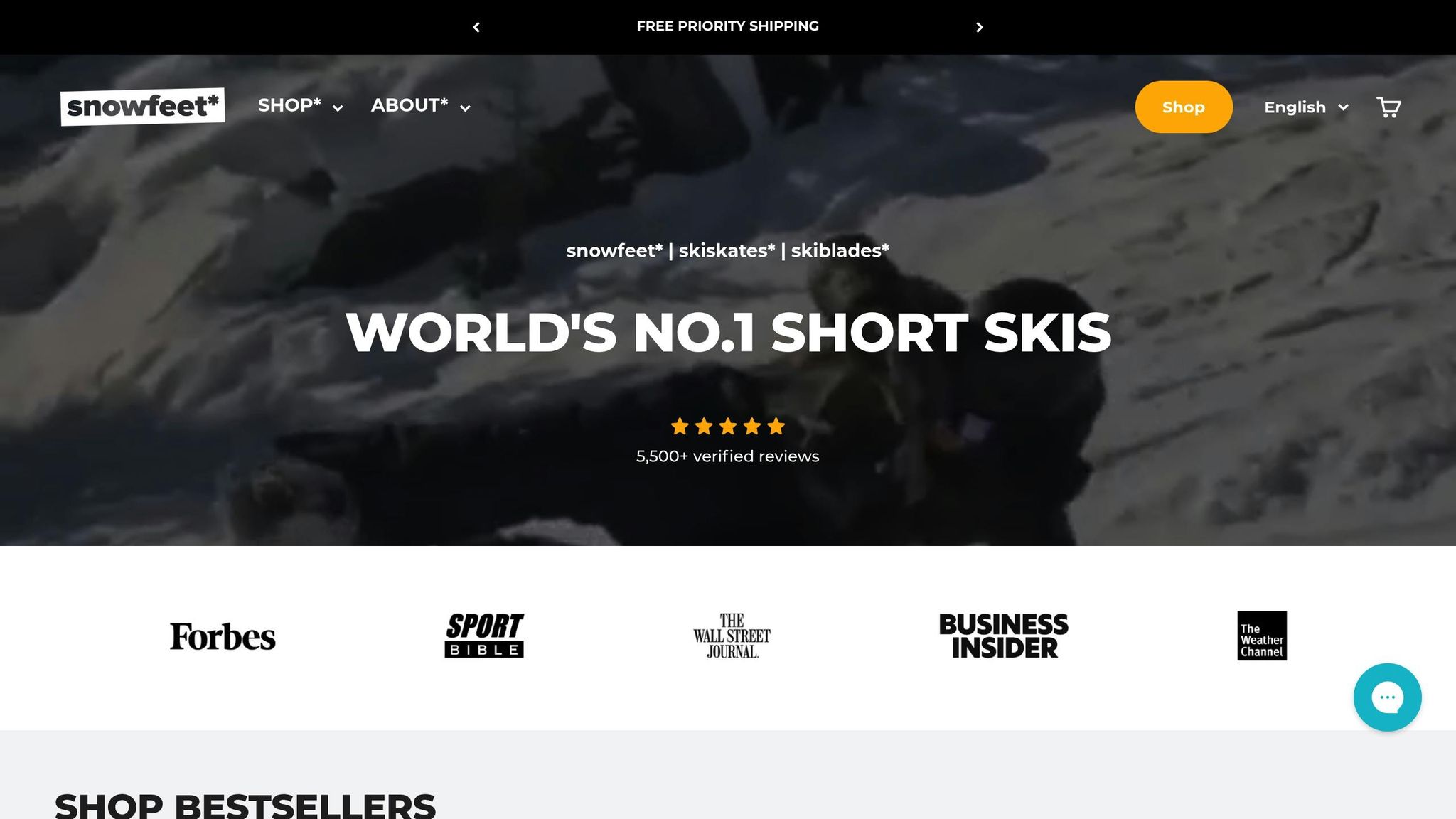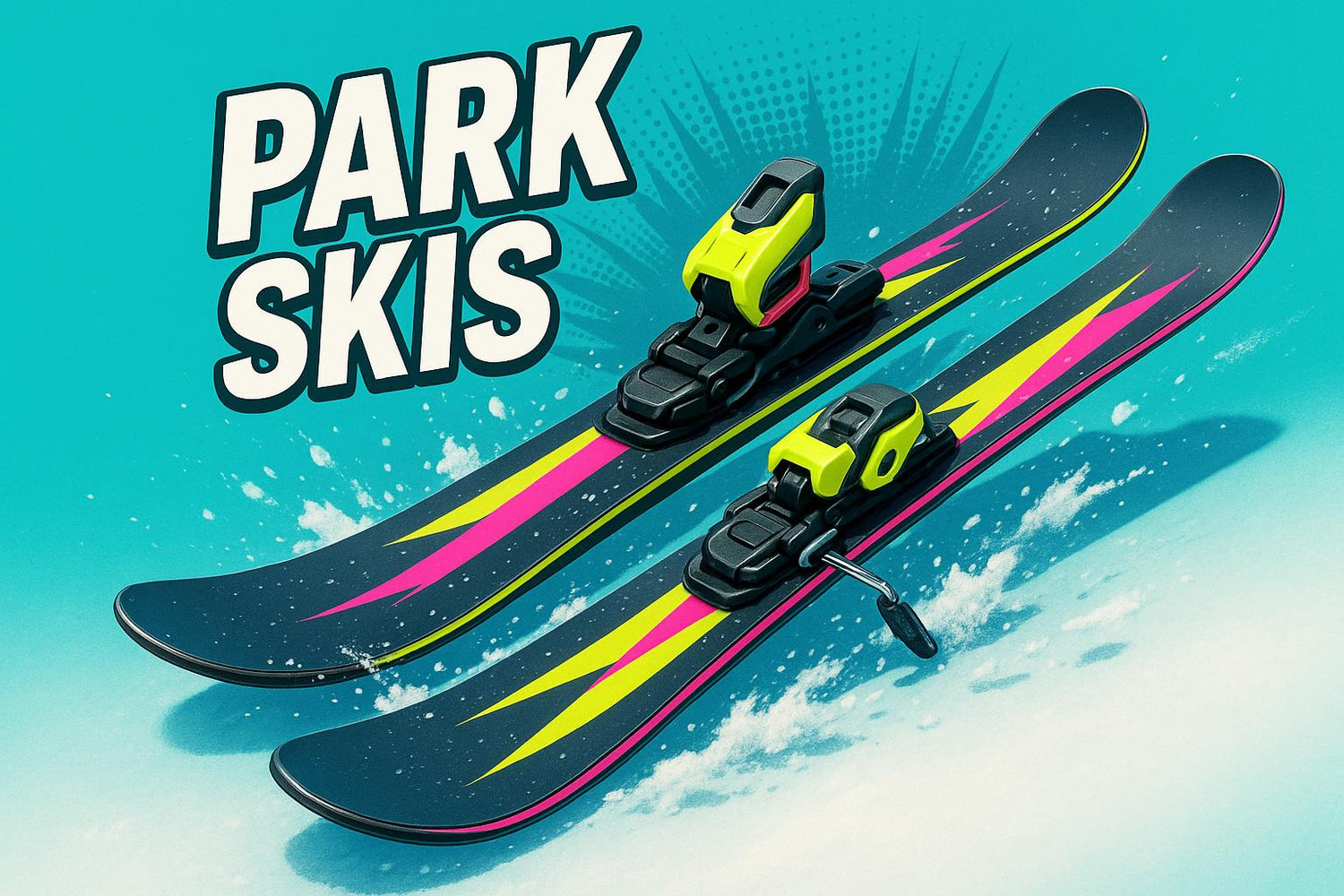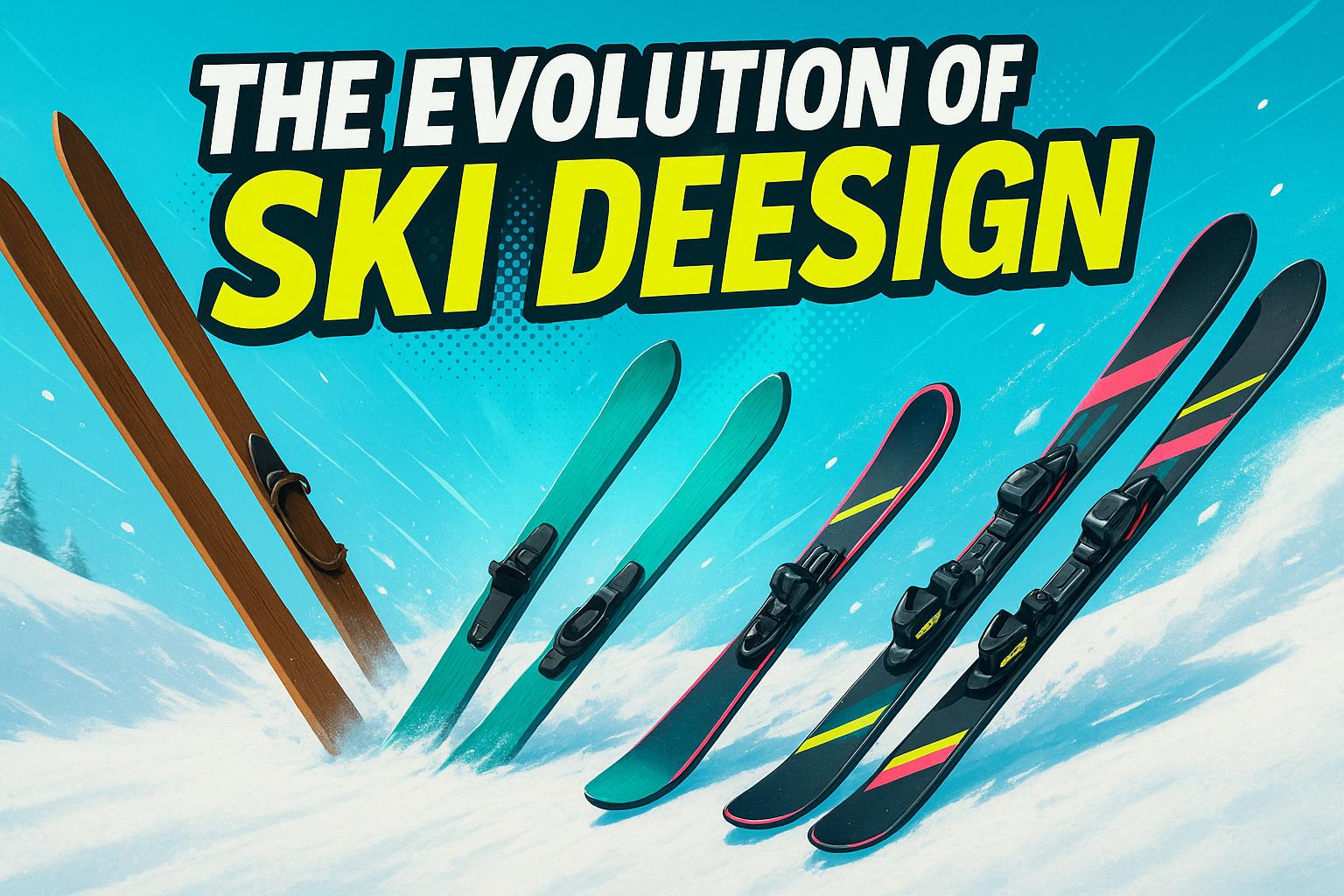ビンディング付きのパークスキーは、テレインパークでのフリースタイルスキーに最適なギアで、ジャンプ、スピン、レールでのコントロール、安全性、敏捷性を高めます。Snowfeet* Skibladesは、短い長さ、軽量設計、さまざまなブーツとの互換性により、従来のパークスキーに代わる際立った選択肢です。以下に簡単な比較を示します:
- 従来のパークスキー:長め(150~200cm以上)、重く、高速安定性と大きなジャンプ向けに設計。スキーブーツが必要で、習得にはより急な学習曲線がある。
- Snowfeet* Skiblades:コンパクト(65~120cm)、初心者に優しく、トリックに非常に扱いやすい。ウィンターシューズ、スノーボードブーツ、スキーブーツに対応。
簡単比較
| 特徴 | Snowfeet* Skiblades | 従来のパークスキー |
|---|---|---|
| 長さの範囲 | 65〜120 cm | 150〜200+ cm |
| 重量 | 軽量 | 重くてかさばる |
| ブーツ互換性 | ウィンターシューズ、スノーボード、スキーブーツ | スキーブーツのみ |
| 習得の難易度 | 初心者に優しい | 技術的なスキルが必要 |
| 価格帯 | $450–$690 | $400~$800以上(ビンディング除く) |
Snowfeet* Skibladesは、携帯性が高く、楽しく、多用途なオプションを求めるパークスキー愛好者に最適です。初心者でも上級者でも、トリックの習得や実行を容易にし、長時間のセッションでの疲労を軽減します。
2025年のベストパークスキー | Newschoolers Gear Weekでレビュー&比較
なぜSnowfeet* Skibladesがスキーパークに最適なのか

Snowfeet* Skibladesはスキーパークで輝きを放ち、敏捷性と遊び心のあるコントロールを兼ね備えています。そのデザインは、素早い動きとクリエイティブなトリックが求められるテレインパークでの定番選択肢となっています。なぜこれらが際立った選択肢なのか、詳しく見ていきましょう。
コンパクトで軽量なデザイン
65cmから120cmまでのサイズ展開で、Snowfeet* Skibladesは精密なコントロールを追求して作られています。コンパクトな形状により、より速いスピン、よりクリーンなグラブ、よりシャープな着地を可能にします。従来のパークスキーのようにかさばることなく、これらのスキーブレードは軽量で、素早い反応性を提供し、長時間のパークセッションでも疲労を軽減します。
始めたばかりですか?65cmモデルはレールスライド、小さなジャンプ、スピンの練習に最適です。経験豊富なライダーには、99cmのオプションがバランスを取っており、遊び心がありつつも安定性が増してスムーズな着地を実現します。
さまざまなブーツに対応
Snowfeet* Skibladesの最もクールな特徴の一つは、そのブーツ互換性です。ウィンターシューズ、スノーボードブーツ、スキーブーツのいずれを好んでも、これらのスキーブレードは対応しています。このような柔軟性は特に、スタイルを変えたりお気に入りのフットウェアにこだわるパークライダーにとってはゲームチェンジャーです。
調節可能なバインディングはギアの共有や異なる条件への適応を簡単にします。HeadやElanのようなブランドの伝統的なパークスキーは特定のブーツが必要ですが、Snowfeet*は自分のスタイルで滑る自由を与えます。
学びやすく、楽しさ満載
Snowfeet* Skibladesは、ローラーブレードのような新鮮な感覚をスロープにもたらし、パークスキーに直感的に適しています。短い長さは動きの自由度を高め、レール、ジャンプ、スピンに挑戦するときの学習速度を上げます。
しかし、恩恵を受けるのは初心者だけではありません。上級ライダーは、これらのスキーブレードが長いスキーでは実現しにくい新しいトリックやスタントの可能性を開くことを愛しています。その軽量で反応の良い作りは創造性を促し、それこそがパークスキーの醍醐味です。さらに、強力な制動力が安全性を高め、スピード管理や混雑したパーク環境でのナビゲーションを容易かつ自信を持って行えます。
Snowfeet* vs 伝統的なパークスキー:並べて比較
Snowfeet*が伝統的なパークスキーとどう比較されるかを見てみましょう。Snowfeet* Skibladesを狙っているか、Rossignol、Atomic、またはHeadのような信頼できるブランドを選ぶかは、最終的にはあなたのライディングスタイルとスロープで求める体験によります。
パフォーマンスとコントロール
伝統的なパークスキーはスピードと安定性が重視されます。一方で、Snowfeet*はタイトで正確なターンとクリエイティブなフリースタイルムーブに焦点を当てています。短くて幅広いデザインは扱いやすく、重くて大きなギアに苦労することなくトリックに集中できます。
ツインチップデザインとセンターマウントバインディングを備えた伝統的なパークスキーでも、高度な技術が求められます。しかし、Snowfeet*はより滑らかな学習曲線を提供し、圧倒されずに上達したい人にとって堅実な選択肢です。
"snowbladesの最高の特徴の一つは、その操作のしやすさです。短いため、管理するスキーが少なく、スキー初心者やもっとリラックスした滑りを求める人に最適です。難しいテクニックに悩まされたり、長くて重いスキーに圧倒されたりすることはありません。"
- Snowfeet Team
フリースタイルファンにとって、この追加されたコントロールは、スピン、グラブ、レールトリックで遊ぶ自由度を高めます。HeadやElanのようなブランドの伝統的なスキーは大きなジャンプでの安定性を提供するかもしれませんが、Snowfeet* Skibladesは実験を促し、新しいトリックに挑戦することを怖がらせません。さらに、そのコンパクトなサイズは持ち運びや収納も簡単にします。
簡単な輸送と保管
従来のパークスキーは通常150 cmから200 cm以上の長さがあり、輸送や保管が面倒です。車に積み込んだり自宅でスペースを確保するには工夫が必要で、ルーフラックが必要になることもあります。
一方、Snowfeet* Skiblades は65〜120 cmと非常にコンパクトで、はるかに便利です。ほとんどの車に簡単に収まり、スペースも最小限です。標準的なスキーバッグも余分なかさばりを気にせず使えます。
比較表:Snowfeet* Skiblades と従来のパークスキー
| 特徴 | Snowfeet* Skiblades | 従来のパークスキー(Rossignol、Atomic、Head) |
|---|---|---|
| 長さの範囲 | 65〜120 cm | 150〜200+ cm |
| 重量 | 軽量 | 重くてかさばる |
| 操作性 | 正確なターンとスピン | 大きく滑らかなターンと高速安定性 |
| 習得の難易度 | 初心者に優しく、操作が簡単 | より高度な技術が必要 |
| ブーツ互換性 | 冬用シューズ、スノーボードブーツ、スキーブーツに対応 | スキーブーツのみ |
| 輸送 | コンパクトで普通車に収納可能 | ルーフラックや大型車が必要なことが多い |
| 地形の多様性 | 整地されたコース、モーグル、パークに対応 | 特定の条件に特化 |
| トリックパフォーマンス | クリエイティブなフリースタイルムーブに最適 | 高速トリックや大ジャンプ向けに設計 |
| 疲労度 | 低く、長時間のセッションが可能 | 重量とサイズによる疲労が大きい |
| 価格帯 | $450–$690 | $400–$800+ (bindings not included) |
多用途性を考慮すると、その違いはさらに際立ちます。従来のパークスキーは特定の条件やパークの特徴に合わせて作られていますが、Snowfeet* Skibladesはさまざまな地形やライディングスタイルに適応します。この適応力は魅力を高めるだけでなく、山での冒険を楽しく柔軟にする選択肢となります。
sbb-itb-17ade95
スキーパークに最適なビンディングの選び方
適切なバインディングはスキーパーク体験を左右します。RossignolやAtomicのような伝統的なアルペンバインディングは整地されたコースに最適ですが、スキーパークは全く別の世界です。ジャンプ、レール、フリースタイルトリックの激しい要求に耐えつつ、安全でコントロールを保てるバインディングが必要です。
パークスキーバインディングに求めるもの
DIN設定から始めましょう。これらの設定はバインディングが外れる力の強さを決定します。パークスキーでは、激しい動き中はしっかり固定され、トラブル時には外れるバインディングが必要です。
多方向リリース機能を備えたバインディングを探しましょう。パークスキーは前後の転倒だけでなく、ねじれ動作、横からの衝撃、不自然な着地も伴います。あらゆる方向にリリースできるバインディングは、予期せぬ転倒時に膝や足首を守ります。
耐久性は譲れません。パークスキーはギアに厳しいため、繰り返しの衝撃やレール、ジャンプの酷使に耐えられる強化されたトウとヒールパーツを備えたバインディングが必要です。
もう一つの重要な特徴は前圧調整です。前圧が緩すぎると、望まない時にバインディングが外れることがあります。逆にきつすぎると、必要な時に外れず怪我につながることもあります。これは、予測不能な力が楽しみの一部であるパークで特に重要です。
Snowfeet*のバインディングはこれらすべての条件を満たし、パークバインディングの新しい可能性を提供します。
Snowfeet* Adjustable Bindings
Snowfeet*のバインディングは、使いやすさ、多用途性、パフォーマンスを兼ね備えています。従来のアルペンバインディングとは異なり、スノーボードスタイルのシステムで設計されており、柔軟で快適、自宅で簡単に調整可能です。5,500件以上の検証済みレビューと驚異の4.9/5評価を誇り、パークスキーヤーの間で人気を博しています。
最大の利点の一つはユニバーサルブーツ互換性です。冬用シューズ、スノーボードブーツ、スキーブーツのいずれをお持ちでも、Snowfeet*のバインディングはすべてに対応します。つまり、高価なスキーブーツを買う必要はなく、既に持っているものや最も快適なものを使えます。
調整可能性も大きな利点です。ドライバー一本でSnowfeet*のバインディングを自宅で調整でき、ショップに行く手間や費用を節約できます。これにより、友人や家族と共有するのに最適で、異なるブーツサイズにも簡単に対応できます。
Snowfeet*は、さまざまなスキルレベルや好みに合わせた3つのバインディングオプションを提供しています:
- Basic bindings:初心者に最適で、トリックの習得を容易にする寛容なフレックスを提供します。
- Standard bindings:中級スキーヤーにバランスの取れた選択肢で、パフォーマンスと快適さを融合しています。
- Pro X bindings:上級者向けに作られており、激しいパークセッション中でも最大限のコントロールと精度を提供します。
ビンディングはつま先とヒールのパーツが調整可能で、様々なブーツサイズに対応しつつ安全性とパフォーマンスを損ないません。従来のビンディングのようにブーツごとに正確な取り付けが必要なく、Snowfeet*のビンディングはその場で適応します。
もう一つの注目ポイントはつま先の高さ調整。歩行によるブーツの摩耗に対応し、Snowfeet*のビンディングならショップに行かずに素早く調整可能です。
スノーボードスタイルのデザインは利便性だけでなくパフォーマンスも重視。衝撃吸収が優れており、パークでの着地時に大きな効果を発揮します。衝撃を直接脚や関節に伝えるのではなく、柔軟なシステムが吸収して疲労を軽減し、長時間パークにいられます。
パークスキーヤーにとって、Snowfeet*のビンディングは絶妙なバランスを実現。初心者はトリックの習得を助ける柔軟性を評価し、上級者は高難度の動きでもしっかりとしたホールドを頼りにできます。初心者から限界に挑むライダーまで、これらのビンディングはパークでの最高の体験をサポートします。
実用的なヒントと製品のおすすめ
パークでのスキルを上げたいですか?Snowfeet*の適切なサイズ、モデル、そして正しいメンテナンス方法を選ぶことが大きな違いを生みます。詳しく見ていきましょう。
適切なサイズの選び方
Snowfeet*は65 cm、99 cm、120 cmの3サイズを提供しており、それぞれ異なるスキルレベルとライディングスタイルに合わせています。
- 65 cm:初心者やスケートやホッケー経験者にぴったり。この短い長さはトリックの習得、狭いスペースのナビゲート、素早いターンを容易にします。
- 99 cm:多用途を求めるライダーに最適な中間サイズ。トリックに機敏でありながら、カービングや大きなジャンプにも安定しています。
- 120 cm:上級者に理想的。このサイズはパークでのパフォーマンスとオールマウンテンの安定性を兼ね備えています。
スキーパークに最適なSnowfeet*製品
適切なサイズを選んだら、次はスタイルと予算に合ったモデルを選びましょう。簡単な概要はこちらです:
- 65 cm Snowfeet Skiblades*:450ドルで、スケーターやトリック愛好者の夢。機動性に優れ、狭いセクションやトリックのレパートリー拡大に最適です。
- 99 cm Snowfeet Skiblades*:490ドルのこのモデルは万能選手。大きなジャンプや高速ランに安定感がありつつ、トリックやレールにも遊び心を発揮します。
- 120 cm Snowfeet Short Skis*:価格は690ドルで、伝統的なスキー体験に機敏さをプラス。パークの楽しさとパウダーデイを両立させたい上級者に最適です。
長持ちするパフォーマンスのためのメンテナンステクニック
ギアの手入れは見た目を良く保つだけでなく、安全性とパフォーマンスのためにも重要です。Snowfeet*を最高の状態に保つ方法はこちらです:
- セッション前のチェック:緩んだネジ、摩耗したビンディング、欠損部品がないか確認してください。特に取り付け部分や摩擦防止装置に注意を払いましょう。
- 使用後は毎回清掃:ぬるま湯と柔らかい布でスキーを洗い、その後しっかり乾かしてください。高圧洗浄機や強い薬品はシールや潤滑剤を傷めるので避けましょう。
- 定期的にワックスをかける:ベースとエッジにワックスを塗ってください。これにより乾燥や錆を防ぎ、パークのフィーチャーを滑った後でも滑走がスムーズに保たれます。
- 賢く保管:スキーブレードは直射日光を避け、涼しく乾燥した場所に保管してください。長期間保管する場合は、ビンディングのスプリングを緩めてテンションと摩耗を減らしましょう。
- 簡単なビンディング修理:Snowfeet*のビンディングはモジュール式なので、ストラップやバックル、その他のパーツをシステム全体を交換せずに取り替えられます。
定期的なメンテナンスはギアの寿命を延ばすだけでなく、パークに行くたびに安全で限界に挑戦できる準備を整えます。
結論:Snowfeet*でスキーパーク体験をレベルアップしよう
Snowfeet* Skibladesは、パークでのコントロールと機敏さを提供することに全力を注いでいます。コンパクトなサイズはフィーチャーでのコントロールを容易にし、軽量設計は長時間のセッションでも素早く機敏に動けるようにします。この組み合わせにより、トリックの成功やパークのナビゲートがスムーズで楽になります。
Snowfeet* Skibladesの鋭い反応性はゲームチェンジャーです。動きに即座に反応し、スピン、ジャンプ、トリックが自然に感じられ、無理している感じがしません。Nathan F.は「雪上で今までで最高に楽しかった」と言い、Andrew B.は「もう元のスキーには戻れない」と語っています。
さらに、Snowfeet*はパフォーマンスだけでなく、スキルレベルに関係なく誰でも簡単に使えます。加えて、その携帯性は大きな利点です。かさばり持ち運びが面倒な伝統的なパークスキーとは違い、Snowfeet* Skibladesはバックパックにすっぽり収まり、急なパークセッションも気軽に行けます。価格は65cmモデルが450ドル、120cmモデルが690ドルです。
Snowfeet*をパークに持って行き、これまでに感じたことのないコントロール、自由さ、楽しさを体験してください。彼らは伝統的なギアでは到底かなわない何かをゲレンデにもたらします。
よくある質問
Snowfeet Skibladesは、パフォーマンスと体験の面で伝統的なパークスキーと比べてどう違いますか?
Snowfeet Skibladesは、そのコンパクトなサイズ、軽量設計、そして比類なき機敏さでパークスキーに新しいアプローチをもたらします。これらのスキーブレードは65cmから120cmの長さで、通常150cmから200cm以上の伝統的なパークスキーよりもはるかに短いです。この短い長さにより、特に初心者やパークの地形を挑戦したい人にとって、操作が簡単で習得も早くなります。
従来のパークスキーは特に深雪でのスピードと安定性に優れていますが、フリースタイルスキーではやや扱いにくく感じることがあります。一方、Snowfeet Skibladesは楽しさと柔軟性を重視しています。そのデザインは遊び心のある動きと多様性を優先し、スキーパークでの魅力的な体験を生み出します。経験豊富なスキーヤーでも初心者でも、そのコンパクトなデザインはトリックやジャンプ、フリースタイルの楽しみに集中したい人にとって刺激的な代替手段を提供します。
Snowfeet Skibladesに対応するフットウェアの種類は何ですか?また、それがパークスキーヤーにどのような利点をもたらしますか?
Snowfeet Skibladesは冬用ブーツやスノーボードブーツなど、さまざまなフットウェアと組み合わせて使えるように作られています。つまり、特別なスキーブーツがなくても楽しめるため、利便性を求めるパークスキーヤーにとって大きなメリットです。
自分のブーツを使うことは快適さだけでなく、アクティビティ間の切り替えも簡単にします。ジャンプの着地やトリックの実行、フリースタイルランのクルージングなど、どんな場面でもこのデザインはシンプルで楽しく、しっかりとしたパフォーマンスを維持します。
パークスキーのパフォーマンスを最大化するために、Snowfeet Skibladesの適切なサイズとビンディングをどう選べばいいですか?
Snowfeet Skibladesの適切なサイズとビンディングを見つけるには、あなたのスキルレベル、スキーのスタイル、挑戦したいトリックやジャンプの種類を考慮してください。65 cmまたは99 cmの短いスキーブレードはフリースタイルやパークトリックに最適で、素早く機敏で非常に操作しやすいです。よりスピードと安定性を求めてゲレンデを滑りたい場合は、120 cmのスキーブレードがより良い選択かもしれません。
ビンディングはブーツのサイズに合い、体重、身長、経験に応じた正しいDINリリース値に調整されていることを確認してください。フリースタイルスキー用に設計された軽量ビンディングは、パークでの動きに必要な柔軟性と反応性を提供するため、優れた選択肢です。Snowfeet Skibladesはコンパクトで遊び心のあるデザインで知られており、RossignolやAtomicのような長くて高速志向のスキーやスノーボードと比べて、トリックやジャンプの習得が容易です。

































コメントを残す
このサイトはhCaptchaによって保護されており、hCaptchaプライバシーポリシーおよび利用規約が適用されます。